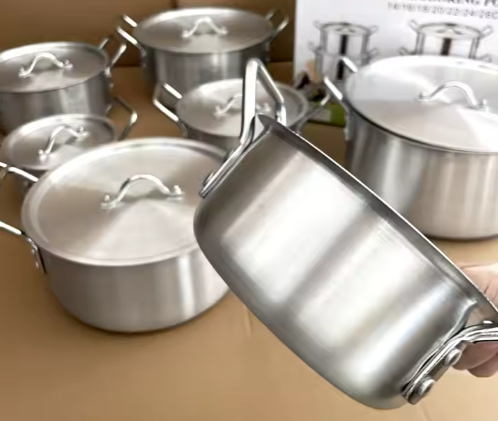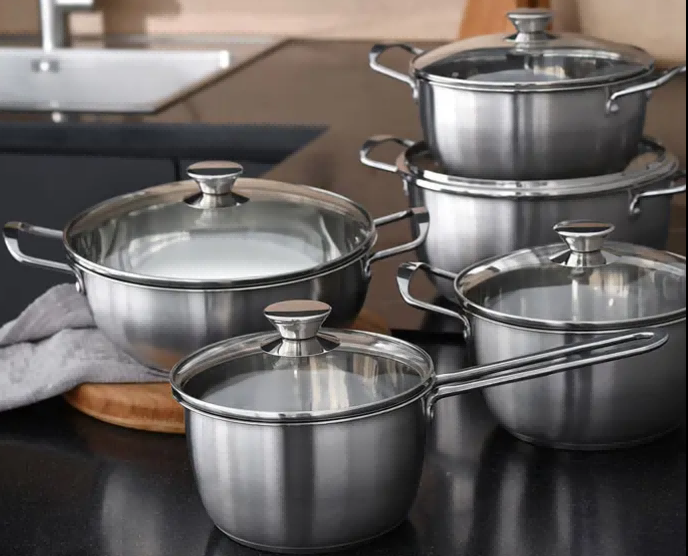Hola a todos, hoy quiero hablaros de dos utensilios de cocina muy comunes: las ollas de aluminio y los batería de cocina de acero inoxidable. Cocinar es una parte indispensable de la vida, y elegir los utensilios de cocina adecuados puede mejorar enormemente nuestra experiencia culinaria. Los utensilios de cocina de aluminio y los de acero inoxidable tienen sus propias ventajas e inconvenientes a la hora de cocinar, y sus diferentes características determinan sus diferentes funciones en la cocina.
Como profesional mayorista de utensilios de cocinale presentaré sus características en detalle, con la esperanza de que pueda elegir mejor la batería de cocina que más le convenga.
Batería de cocina de aluminio: Transferencia de calor eficiente
Los utensilios de cocina de aluminio son muy populares en las cocinas comerciales y domésticas por su excelente conductividad térmica.
Ventajas de los utensilios de cocina de aluminio
Conductividad térmica: Las ollas de aluminio pueden transferir el calor de forma rápida y uniforme, y su conductividad térmica es varias veces superior a la de la mayoría de los metales, lo que hace que el proceso de cocción sea más eficiente. Para los empleados y trabajadores, es especialmente ahorrador de tiempo utilizar ollas de aluminio para cocinar comida rápida ¡para preparar el desayuno rápidamente!
Ligero: La batería de cocina de aluminio es muy ligera, fácil de transportar y muy cómoda de usar, adecuada para cocinar al aire libre o en la cocina diaria.
Económico: En comparación con otros materiales, los utensilios de cocina de aluminio son más asequibles debido a sus abundantes recursos de aluminio y a sus costes de transformación relativamente bajos.
Desventajas de los utensilios de cocina de aluminio
Pero también tiene desventajas:
No resistente al desgaste: El aluminio es blando y se raya con facilidad, lo que afecta a su aspecto y vida útil.
No le gustan los alimentos ácidos: El aluminio es propenso a las reacciones químicas en un entorno ácido, lo que provoca su disolución, que tendrá cierto impacto en la salud humana.
No resiste altas temperaturas: Aunque el aluminio tiene una buena conductividad térmica, su punto de fusión es relativamente bajo. Las sartenes de aluminio puro se deforman fácilmente a altas temperaturas y no son adecuadas para barbacoas de alta temperatura ni para calentar a altas temperaturas durante mucho tiempo. Por eso, a muchas sartenes de aluminio se les da un revestimiento antiadherente o se anodizan para aumentar su durabilidad.

Batería de cocina de acero inoxidable: Duradera y segura
La batería de cocina de acero inoxidable es sinónimo de "durabilidad" en la cocina y también es una opción muy avanzada.
Ventajas de los utensilios de cocina de acero inoxidable
Seguridad: La batería de cocina de acero inoxidable no reacciona con los alimentos ácidos o alcalinos, y no libera sustancias nocivas a altas temperaturas. Es una elección muy segura.
Fácil de limpiar: El acero inoxidable tiene una superficie lisa y no es fácil que absorba restos de comida. Puede limpiarse fácilmente con detergente común y un paño suave.
Desventajas de los utensilios de cocina de aluminio
Mala conductividad térmica: El acero inoxidable de una sola capa no es tan conductor como el aluminio, lo que significa que puede tardar más en alcanzar la temperatura ideal para cocinar cuando se calienta. ¡Sin embargo, ahora hay en el mercado muchas ollas de acero inoxidable de fondo compuesto de tres capas, que combinan la conductividad térmica del aluminio con la durabilidad del acero inoxidable y se convierten en la mejor opción para cocinar!
Precio más alto: Las baterías de cocina de acero inoxidable de alta calidad suelen estar diseñadas con múltiples capas de materiales compuestos para mejorar la conductividad térmica y la durabilidad. Estos costes de proceso y materiales hacen que el precio de las baterías de cocina de acero inoxidable sea generalmente más elevado que el de algunas baterías de cocina tradicionales, adecuadas para usuarios que persiguen la calidad.

Ollas de aluminio frente a ollas de acero inoxidable
| Aspecto | Batería de cocina de aluminio | Batería de cocina de acero inoxidable |
| Conductividad térmica | Excelente conductividad térmica, se calienta rápida y uniformemente, ideal para cocinar rápido. | Mala conductividad térmica en diseños de una sola capa, pero las opciones multicapa mejoran el rendimiento. |
| Peso | Ligero y fácil de manejar, ideal para cocinas pequeñas o uso en exteriores. | Más pesado, ofrece mayor estabilidad y es adecuado para un uso prolongado en la cocina. |
| Durabilidad | Material más blando, propenso a arañazos y deformaciones. | Duradero, resistente a la corrosión y a prueba de arañazos. |
| Precio | Más asequible con una alta rentabilidad. | Mayor coste inicial pero mayor vida útil, lo que lo hace más económico a largo plazo. |
| Salud y seguridad | Puede reaccionar con alimentos ácidos o alcalinos, lo que plantea riesgos potenciales. | No reacciona con los alimentos, lo que garantiza un alto nivel de seguridad. |
| Facilidad de limpieza | El revestimiento antiadherente es fácil de limpiar, pero puede desgastarse con el tiempo. | La superficie lisa no se pega, lo que facilita la limpieza. |
| Apariencia | Disponible en varios colores, a menudo con acabados anodizados. | Elegante acabado metálico de aspecto clásico y elegante. |
| Resistencia al calor | El aluminio puro puede deformarse a altas temperaturas; los revestimientos antiadherentes tienen una resistencia limitada. | Excelente resistencia al calor, mantiene la forma a altas temperaturas. |
| Mejores escenarios de uso | Ideal para cocinar rápidamente y sin salirse del presupuesto. | Perfecto para quienes dan prioridad a la calidad, la seguridad y la longevidad. |
Elección entre los dos
Si se centra en la rentabilidad y a menudo necesita cocinar rápidamente, los utensilios de cocina de aluminio serían una buena elección.
Si lo que busca es durabilidad y seguridad e higiene, la batería de cocina de acero inoxidable sería más adecuada. En particular, el diseño de fondo compuesto tiene en cuenta tanto el calentamiento rápido como la cocción uniforme.
Resumen
Las baterías de cocina de aluminio y las de acero inoxidable tienen sus propias características. Lo más importante es elegir la batería de cocina adecuada a sus necesidades reales.
Si el presupuesto es suficiente, puede considerar mezclar y combinar, como sartén de aluminio + olla sopera de acero inoxidable. También puede combinar las ventajas de ambos y elegir un wok de acero inoxidable con fondo de aluminio compuesto de tres capas, con el que no solo podrá disfrutar de la conducción rápida y uniforme del calor del aluminio, sino que también tendrá en cuenta la durabilidad y seguridad del acero inoxidable.
Espero que a través del intercambio de este artículo, todo el mundo puede tener una comprensión más profunda de las características de los utensilios de cocina de aluminio y acero inoxidable, y ayudarle a elegir los utensilios de cocina más adecuados.
